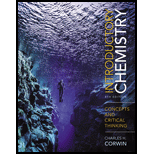
Concept explainers
(a)
Interpretation:
The maximum number of electrons that can be occupied by
Concept introduction:
An atom is made up of three subatomic particles-neutrons, protons, and electrons. Neutrons and protons are present in the nucleus of the atom, whereas electrons are revolving outside the nucleus in an atom. The electrons are arranged in the subshell of atoms according to their energy.
(b)
Interpretation:
The maximum number of electrons that can be occupied by
Concept introduction:
An atom is made up of three subatomic particles-neutrons, protons, and electrons. Neutrons and protons are present in the nucleus of the atom, whereas electrons are revolving outside the nucleus in an atom. The electrons are arranged in the subshell of atoms according to their energy.
(c)
Interpretation:
The maximum number of electrons that can be occupied by
Concept introduction:
An atom is made up of three subatomic particles-neutrons, protons, and electrons. Neutrons and protons are present in the nucleus of the atom, whereas electrons are revolving outside the nucleus in an atom. The electrons are arranged in the subshell of atoms according to their energy.
(d)
Interpretation:
The maximum number of electrons that can be occupied by
Concept introduction:
An atom is made up of three subatomic particles-neutrons, protons, and electrons. Neutrons and protons are present in the nucleus of the atom, whereas electrons are revolving outside the nucleus in an atom. The electrons are arranged in the subshell of atoms according to their energy.
Want to see the full answer?
Check out a sample textbook solution
Chapter 4 Solutions
Introductory Chemistry: Concepts and Critical Thinking (8th Edition)
- 2.42 What is a period in the periodic table? From what does it derive its name?arrow_forwardHow are electrons and protons similar? How are they different?arrow_forwardHow many orbitals correspond to each of the following designations? (a) 3p (b) 4p (c) 4Px (d) 6d (e) 5d (f) 5f (g) n = 5 (h) 7sarrow_forward
- Chemistry: Matter and ChangeChemistryISBN:9780078746376Author:Dinah Zike, Laurel Dingrando, Nicholas Hainen, Cheryl WistromPublisher:Glencoe/McGraw-Hill School Pub Co
 General, Organic, and Biological ChemistryChemistryISBN:9781285853918Author:H. Stephen StokerPublisher:Cengage Learning
General, Organic, and Biological ChemistryChemistryISBN:9781285853918Author:H. Stephen StokerPublisher:Cengage Learning  Chemistry & Chemical ReactivityChemistryISBN:9781133949640Author:John C. Kotz, Paul M. Treichel, John Townsend, David TreichelPublisher:Cengage Learning
Chemistry & Chemical ReactivityChemistryISBN:9781133949640Author:John C. Kotz, Paul M. Treichel, John Townsend, David TreichelPublisher:Cengage Learning Chemistry & Chemical ReactivityChemistryISBN:9781337399074Author:John C. Kotz, Paul M. Treichel, John Townsend, David TreichelPublisher:Cengage Learning
Chemistry & Chemical ReactivityChemistryISBN:9781337399074Author:John C. Kotz, Paul M. Treichel, John Townsend, David TreichelPublisher:Cengage Learning Chemistry for Engineering StudentsChemistryISBN:9781337398909Author:Lawrence S. Brown, Tom HolmePublisher:Cengage Learning
Chemistry for Engineering StudentsChemistryISBN:9781337398909Author:Lawrence S. Brown, Tom HolmePublisher:Cengage Learning





